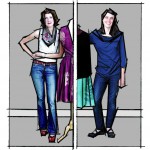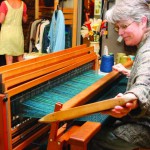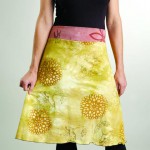- Jen Swearington (left) and Jude Stuecker. Jonathan Welch
- The trendy part of nostalgia: Guild weaver Liz Spear is a traditional artist, but says the Asheville area’s young crafters run the gamut from classic to edgy. Jonathan Welch
- Colorful, whimsical: A stylish skirt from Guild artist Jude Stuecker. Courtesy SHCG
Handmade apparel, wearable art, DIY, craft: These are well-worn terms in local lingo. They also call to mind certain retail opportunities, like the artist booths at LEAF and The Big Crafty. But the forerunner to both of these (and, for that matter, to the current crafting craze, Church of Craft groups, Stitch ‘n Bitch circles, Etsy.com, etc.) is the twice-a-year Craft Fair of the Southern Highlands. That event (which showcases works from some of the Southern Highlands Craft Guild’s more than 900 members) has been going strong since 1948.
The fact that the craft fair is older than the parents of most of The Big Crafty's exhibitors might have something to do with the impression that it's a little bit staid. Or antiquated. (And there is the traditional dyeing exhibit held outside of the Civic Center when the craft fair is in session.) "People think it's more conservative and traditional than it really is," says gGuild member and apparel designer Jude Stuecker. "I did, too, before I joined."
Self-taught style
It's hard to get farther from Appalachian weaving looms and vegetable dyes than Jennythreads, the sunny, modern, downtown West Asheville studio of local designer Jen Swearington. The busy space is filled with sewing machines, a cutting table and racks of jersey dresses and striped shirts. It looks more like the walk-in closet for an indie band than the work bench of a fiber artist. But Swearington is quick to identify herself as a crafter rather than a fashion maven.
"I've never studied fashion," she says. "I'm not very fashion oriented. It's been interesting to figure out construction and what's wearable and what's flattering."
Swearington started out making wall pieces that resemble quilts but involve painting and other processes that she works on in secret. It was that work that earned Swearington membership in the Southern Highland Craft Guild in 2003, but as her first Craft Fair of the Southern Highlands approached, she realized that she needed wearable items for purchase at her booth. "In graduate school I'd studied fibers and did some scarves," she says. "But I couldn't do a whole booth of scarves. So I thought, 'Why don't I try to make a skirt and a top?'" And that was the beginning of her apparel line.
She began working with silk, and now uses silk with Lycra, "which hangs beautifully," and which she dyes herself. She taught herself to design by tracing her own clothes and looking at commercial patterns for sizing. "For the first three years, people were like, 'Jen when are you going to put sleeves on something?,'" she says. "Sleeves are hard!"
These days Swearington does sleeves, as well as graceful halter dresses and T-shirts printed with the same sketches that she applied to her wall pieces in the past.
Stuecker is also largely self-taught (though these days many of the Guild members who show at the biannual craft fair wear her colorful, whimsical dresses, tops and skirts). It wasn't until college that she started seeking instruction. "Every time I would meet someone who did that professionally, or I would look at a book, I would learn something new," she says. "It made me realize how much I was missing out by just trying to figure stuff out on my own."
Stuecker got her start making large-scale quilts — though not in historic Appalachian patterns, nor at the knee of her grandmother. "I never made traditional quilts," she says. "But as I became a more professional artist, I learned a lot from traditional quilters about certain techniques. I learned that it's really important to make something well."
Stuecker says that, in the beginning, she was being creative, but the time came when it was important that what she made didn't fall apart. One quilter told her about interfacing (used to bind and reinforce fabric) which Stuecker says "changed everything. Once I got some skills, I felt like I could express myself more effectively."
Stuecker met Swearington during a session at Penland, and it was Swearington who encouraged her to make clothing "because women always buy clothes, no matter how many they have. It's hard to resist."
”Nobody's doing Liberty blouses”
Swearington and Stuecker are two local artists and Guild members whose work will be represented at Fiber Weekend at the Folk Art Center. The annual celebration of fiber arts offers the perfect opportunity to watch crafters at work.
Demonstrations include quilting, doll making, weaving, mixed-media fiber arts, clothing design, printing and surface design, and natural dyeing. If most of that sounds fairly traditional, the Sunday afternoon Fashion Show of Wearable Art features many contemporary themes — recycling and repurposing among them. "Styles showcased will range from contemporary to traditional, from funky to classic," says the Folk Art Center webpage.
So yes, there will be funky. And that offbeat modern spin will be done with a nod to traditional crafting — at least with respect to workmanship. Which is not to say the same isn't true for beloved indie craft fairs and Etsy sellers, but membership to the Craft Guild is determined by a jury, and expectations are high. (That's also one reason Stuecker suspects more local artists don't apply — it's an intimidating process. But, "I'm always surprised when people are not in the Guild," she says. "It's such a great resource for artists.")
"The fiber art I see at Guild shows and galleries appeals to a wide range of people, from more fashion-conservative women who appreciate impeccable quality and design to young artists who want clothes that reflect their style and individuality — clothes that are comfortable and artful," says April Nance, Southern Highland Craft Guild public relations manager.
Liz Spear, who emcees the wearable art fashion show, is a long-time guild member. She knows a lot about the marriage of quality, comfort and artistry. She's been a professional weaver since the mid-'90s, and her work includes collared and kimono-style jackets. "What I make is fairly conservative," she says. "Most of my customers are women with office jobs. I make what I like and that happens to be the demographic it fits." But of the seven to nine other fiber artists at each guild fair, Spear says they run the gamut from classic to edgy.
"Nobody's really doing traditional garments," she says. "What's a traditional garment? Nobody's doing aprons or homespun Liberty blouses." (Liberty & Co., during the late 1800s, made high-necked blouses with long sleeves.)
Spear says her some of the younger crafters around Asheville are involved in "the trendy part of nostalgia, and that moves over into the fine craft world." Just like trends on the streets inform high fashion, in the craft world, "the trendy stuff is sometimes riding on the wave of what’s happening in the rest of the culture," says Spear. "And sometimes it’s riding the wave of the newest technique."
According to Spear, painting, surface technique and felting are the current trends. She's started incorporating wet felting with colored fleece into her work. "I end up with a beautifully textured sort of fabric that's very different from my weaving," she says.
While some artists are tuned in to (or forerunners of) trends, others return to tradition. In the case of Kumihimo craftsman Tim Clark, the tradition of Japanese braid-making was so historic and obscure that it seems downright cutting-edge today.
A musician and composer, Clark had little interest in taking up a craft, until about 10 years ago when he came across a book on Japanese braiding. "There was something so interesting in the mathematics," he says. The technique creates either round or flat straps whose colorful threads form intricate patterns (some are geometric, others have floral motifs or fan patterns). Clark is one of the few male fiber artists (the discipline is dominated by women); he might have been attracted to Kumihimo in part because it was used by the Samurai for armor lacing.
Clark began collaborating with his partner, Linda MacMichael, fashioning straps for her quirky/ingenious handbags. The couple rarely makes the bags these days — the straps take too much time to be sold at an affordable price. Currently, Clark is contributing to a book about Japanese braiding.
Runway-bound
Browse the Guild members under the fiber medium, and you'll find a wild array of creations. Among the 67 names or partnerships, there are quilters and printmakers, crochet and handloom artists, bead weavers and basket weavers, felters and surface designers.
"The Guild is a diverse group and the work produced by members working in textiles reflect that wide spectrum," says Nance. "Guild fashion is inclusive."
In a way, the fiber world also seems to be inclusive. Like Spear, crafters in the medium tend to specialize in one creative pursuit while also experimenting with or applying techniques from another. The result is often innovative.
Stuecker has evolved from working solely in quilts to only making a few a year. They're time consuming and not as lucrative as apparel. But now, "The quilts are a treat for me to make," she says. She's affiliated with L.I.N.T (Ladies In New Textiles) and, with that group, "I made a quilt in response to the poem 'Change of Season' by Audre Lorde," she says.
The bulk of Swearington's work, too, is concentrated on garments, to the point that she has a part-time assistant, Ashley Cole, for production work. (To help Swearington win funding to hire Cole full time, go to lovealocalbusiness.intuit.com/pages/fan and search "Jennythreads, Inc.") But she still challenges herself with a variety of gallery shows for her wall hangings and, most recently, a fiber-arts tea pot for the National Tea Pot Show in Creedmoor, N.C.
Don't want to drive to the coast to see innovative art? "Fiber Weekend is a great way to showcase this diversity — to reflect on processes of making textile art and the final product, from weaving to dyeing and surface design, from sewing to repurposing," says Nance. And it's all sent down the runway on models.
"We've got a couple of new Guild members this year who I'm really excited about," says Spear. One, from Hendersonville, makes felted garments and accessories. Another, from Sweetwater, Tenn., makes quilted garments that are "jaw droppingly gorgeous. Exquisite work," says Spear.
What keeps Spear involved with the wearable-art fashion show? "Getting to meet the work," she says.
— Alli Marshall can be reached at amarshall@mountainx.com.
what: The Southern Highland Craft Guild’s Fiber Weekend and 12th annual Fashion Show of Wearable Art, with demonstrations and activities
where: Folk Art Center, Milepost 382 on the Blue Ridge Parkway (298-7928)
when: Saturday and Sunday, May 14 and 15 (Free. Saturday: fiber craft demos, 10 a.m.-4 p.m. Sunday: two fashion shows, 1 and 3 p.m. southernhighlandguild.org)







Amazing work these people do! Also, i want to say that i love, love LOVE the cover and stylistic additions that Roney has made to the article!